MARIANI’SVirtual
Gourmet
December
25, 2011
NEWSLETTER

❖❖❖
A PROUD
ANNOUNCEMENT
from John Mariani
I have just been chosen as one of five
recipients for the 2012 edition of the Grana Padano Italian
Cuisine Worldwide Awards, "to honor
individuals who
have made an outstanding contribution to the
promotion and/or knowledge of the Italian
food and wine culture in the countries they
live, in the last year or during their life.
In your case the jury has intended to reward
especially the excellent work you have done
with your recent book How Italian
Food Conquered the World as well
as the contribution you have given during
your whole career. The nominations of
the candidates came from the network of the
200 ICMC
– Italian Cuisine Master Chefs and
were evaluated by a jury of experts."
❖❖❖
THIS WEEK
by John Mariani
❖❖❖
NEW YORK
CORNER
Mas (la grillade)
by John Mariani
❖❖❖
Gin Seeks a Return to the Spotlight
by John Mariani
❖❖❖
by John Mariani
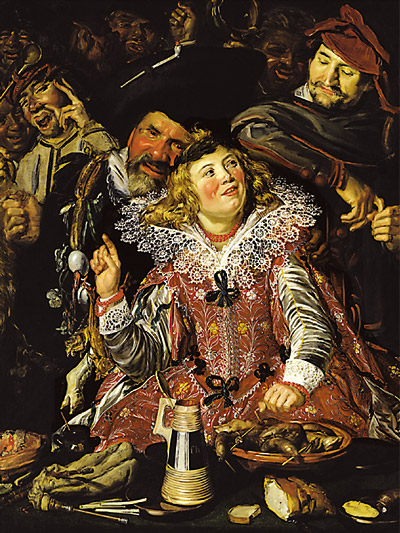
As in any major capital in Europe these days, the options for enjoying just about any kind of cuisine is high, whether it's sushi, pizza, or tapas. And in that regard Amsterdam may well be richer in such options than Paris or Rome. Short-term visitors to Amsterdam will want to partake of the more indigenous restaurants, from low to high, that are everywhere. Amsterdammers love eating out, so you'll find the restaurants packed with the locals, while the tourists tend to go where tourists are told to go.
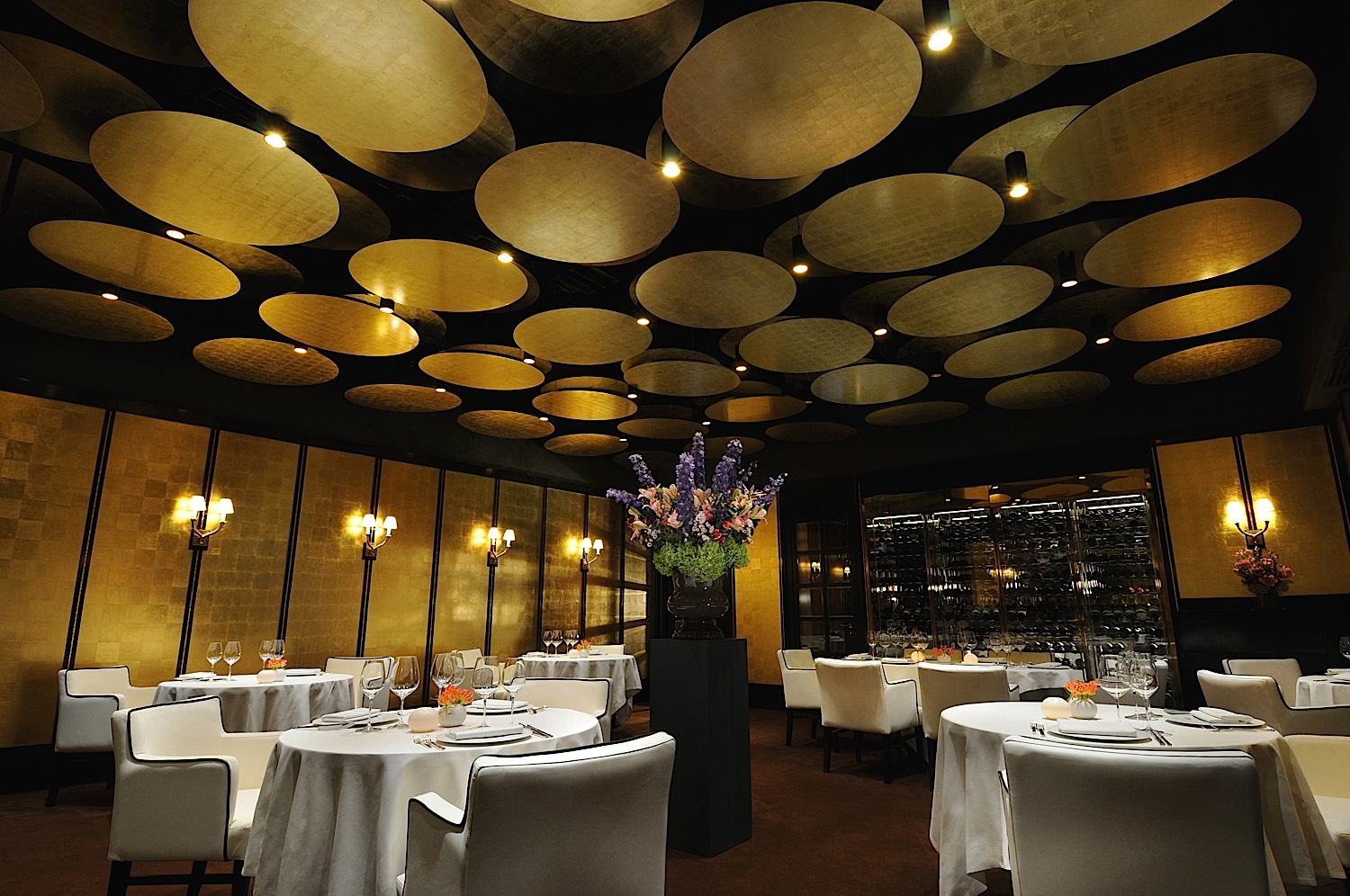 The
biggest dining news in the city is the opening of Bord' Eau in
the renovated--61 million euros--Hotel de L'Europe (Nieuwe Doelenstraat 2),
where Sommelier Dannis Apeldorn oversees a
first-rate winelist, with 24 wines by the glass, and
79 bottles under 50 euros, plus another thousand
selections to choose from. You might, then, wish to
first have a drink at the hotel's beautiful Freddy's
Bar (named after Alfred "Freddy" Heineken, one of
the most elegant of the so-called "brown bars"
(referring to their color) in the city and more
sophisticated than any.
The
biggest dining news in the city is the opening of Bord' Eau in
the renovated--61 million euros--Hotel de L'Europe (Nieuwe Doelenstraat 2),
where Sommelier Dannis Apeldorn oversees a
first-rate winelist, with 24 wines by the glass, and
79 bottles under 50 euros, plus another thousand
selections to choose from. You might, then, wish to
first have a drink at the hotel's beautiful Freddy's
Bar (named after Alfred "Freddy" Heineken, one of
the most elegant of the so-called "brown bars"
(referring to their color) in the city and more
sophisticated than any.Bord'Eau (left), the name is a pun meaning "next to the water" as here and in the French wine region), which replaced the outdated Excelsior. It is very elegant even posh in a very contemporary range of colors and soft gold lighting, flowers, superb tablesettings, thick linens and fine stemware. You know you're off to a good start when the butter and breads are as good as they are here. A pretty amuse set the stage for what followed, a pizza crisp topped with lobster cannoli and a lollipop of octopus. Executive Chef Richard van Oostenbrugge (below) and Chef Thomas Groot have fashioned menu that is as modern--without being "modernist"--as any in Europe. It is playful but always based on sound culinary principles, as evident in a dish of autumn vegetables with a pistachio vinaigrette and cous-cous style rice with Pierre Robert cheese whipped into a cream.
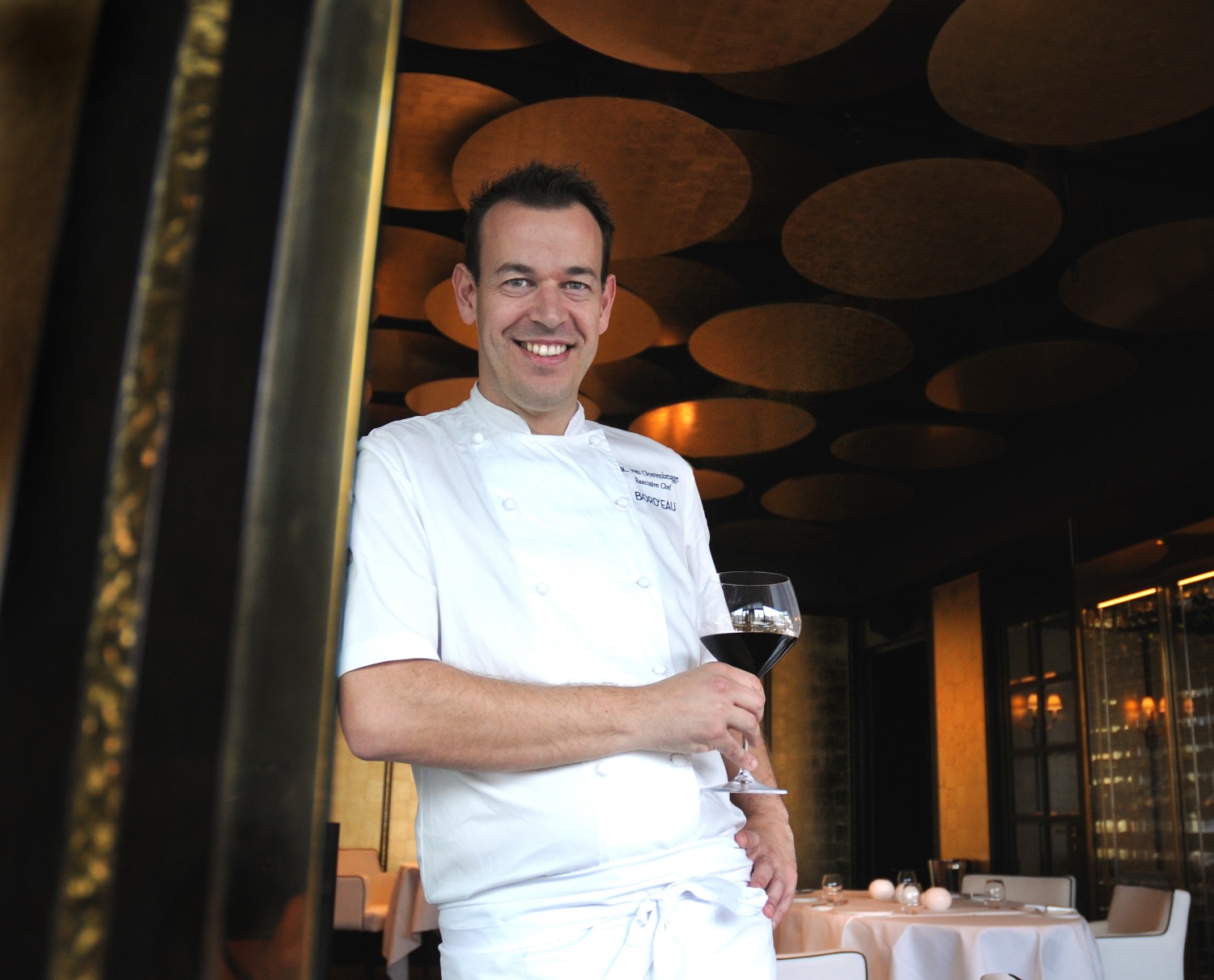
"Mac & Cheese" came with butternut squash, pearl radish and Saint Marcellin cheese, while a plate of crisp sweetbreads were matched with a risotto-style Taggiasche olives and celery root--all the flavors winningly complementary.
Main courses followed in the same balance, beginning with a fillet of red mullet and jus bécasse (woodcock), watercress salad and roasted toast. A big, well-fatted Anjou squab came with an Asian touch of orange and soy, cabbage and peanuts, which might well have appeared on a rijsstaffel feast but is far better on its own. Lozère lamb had the bite of lemon confit and capers, Niçoise vegetables and lamb jus. And a dry-aged (unusual in Europe) Simmenthaler loin and neck of beef came with stewed vegetables, rich pork belly and an ever richer Bordelaise sauce.
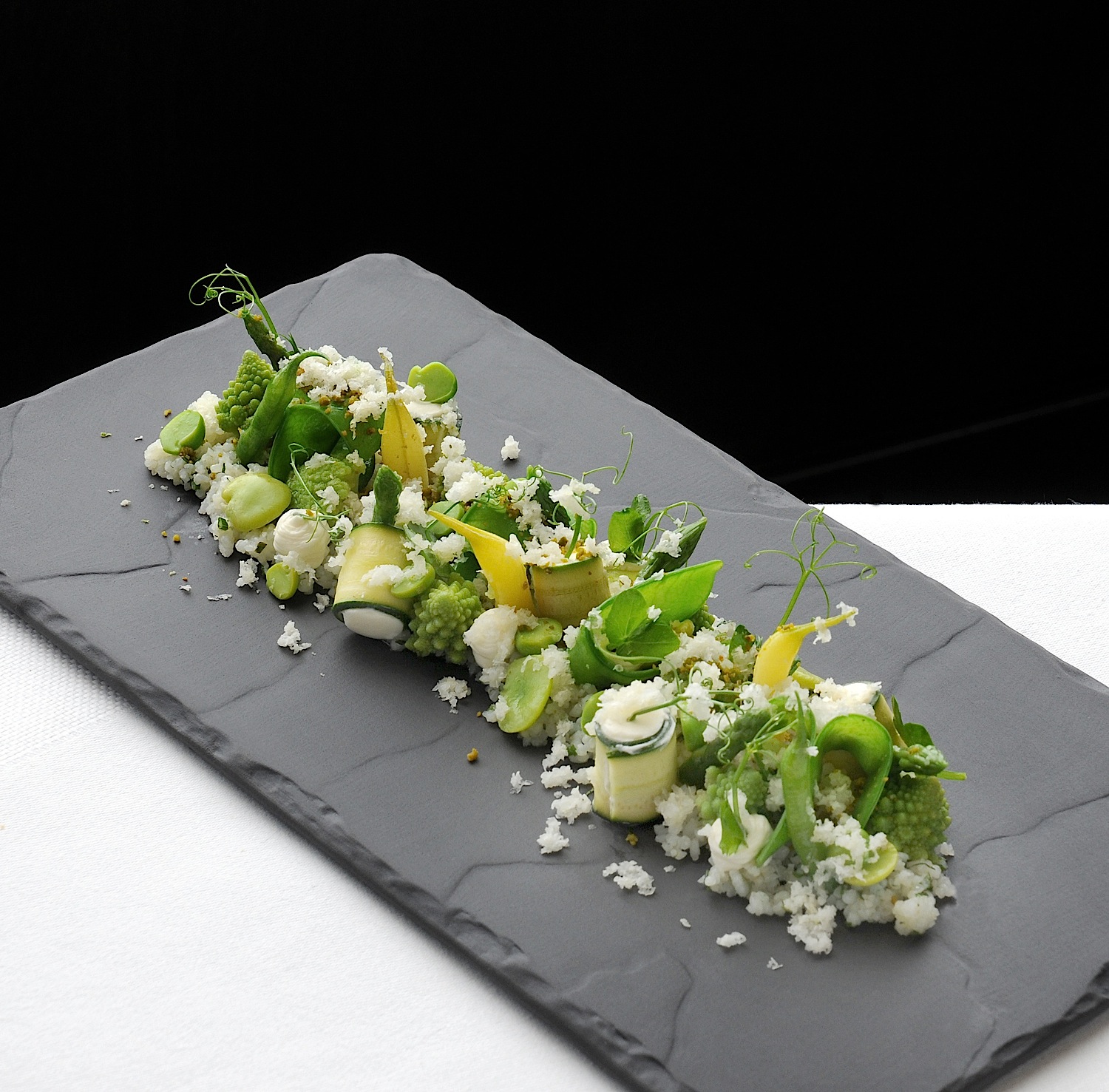 You, of course, expect
desserts to be sumptuous in a restaurant of this
caliber, and they certainly are, from cocoa
bean moelleux with
chocolate mousse and crumble to a wild peach Melba
with white currants and crispy almonds.
You, of course, expect
desserts to be sumptuous in a restaurant of this
caliber, and they certainly are, from cocoa
bean moelleux with
chocolate mousse and crumble to a wild peach Melba
with white currants and crispy almonds.There is a four-course menu at 66 euros ($86), five for 76, and six for 88, which are very reasonable prices, especially since à la carte prices are 18 euros-56 euros, and main courses 36 euros to 66 euros, though those same main courses may be ordered more cheaply in smaller portions. Prices for similar haute cuisine in Paris would cost double that. Service, as everywhere in Holland, is included.
The hotel also has a casual Hoofdstad Brasserie on premises with an open kitchen, open for breakfast, lunch and dinner.
High-end, deluxe restaurants have long been part of the Amsterdam dining scene, with established places like Roberto in the Hilton, Christophe, Breitner, and the landmarked Café Americain, but, as elsewhere in Europe, few are outside those hotels that can pay the kind of money it takes to do open such places. Bridges (below) is just such a new restaurant, situated in the Sofitel along the Oudezijds Voorburgwal canal and was not long ago a municipal canteen. In
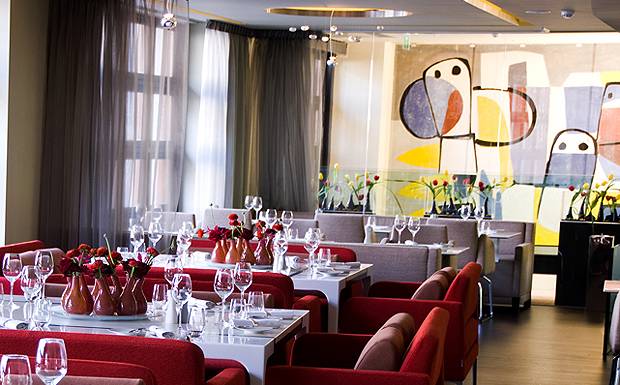 Lighting at
night is a little low in which to read the small
print on the menu.
Lighting at
night is a little low in which to read the small
print on the menu. Bridges, with a smart bar up front (below), is a mainly seafood restaurant, and the focus is absolutely on the main ingredient on the plate, with few additions to detract from its exquisite freshness, as fashioned by Chef Aurélien Poirot. Sommelier Hans Tuin has culled his excellent list to reflect this same idea and is happy to match wines with dishes, since most on his list can be ordered by the glass.
Our table of four ordered broadly across the ever-changing menu, following an amuse of smoked salmon and mussels. Oysters came with cucumber, tinged with tarragon foam and shallots. A detour from the seafood menu ("From the Field") was the fine, silky foie gras with more foam,
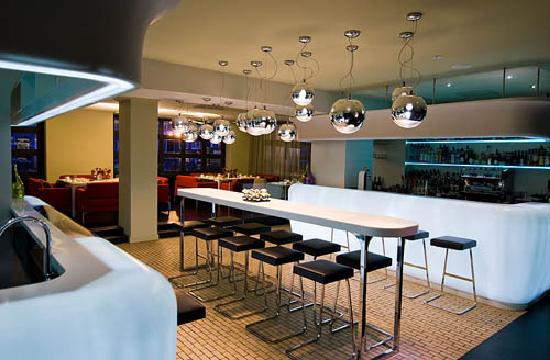 this time
potato and sea salt, and a plate of well-made
gnocchi lashed with lemon oil and shavings of
Parmigiano.
this time
potato and sea salt, and a plate of well-made
gnocchi lashed with lemon oil and shavings of
Parmigiano.Returning to seafood form, we had selections from the raw side of the menu, pearl-like scallops and salmon of pristine quality, then tuna tartare in a cream sauce, with pommes pont neuf and salad. A half lobster cooked in a tandoor with Indian-style naan bread was good, but like several dishes that evening, quite salty.
Prices are pretty high, but this quality of seafood comes dear, with starters 14 euros to 49 euros, and main courses 22 euros to 105 euros (this last for wild turbot and caviar).
I found a new favorite place to have lunch or dinner, near the Concert Hall on the broad Avenue Van Baerlestraat,
 named Brasserie
van Baerle (right), now two decades old. The
interior of the dining room is a rare enchantment,
with wonderful lines, glossy white ceilings, deep
purple banquettes, little lamps on the table, white
tablecloths, big mirrors, and a window over the
street. Outside there is a favored patio, though my
guest and I scurried back inside because smoking is
allowed outside and there was plenty of it going on.
named Brasserie
van Baerle (right), now two decades old. The
interior of the dining room is a rare enchantment,
with wonderful lines, glossy white ceilings, deep
purple banquettes, little lamps on the table, white
tablecloths, big mirrors, and a window over the
street. Outside there is a favored patio, though my
guest and I scurried back inside because smoking is
allowed outside and there was plenty of it going on.The proprietor and her well-trained staff delivered an amuse of creamed mushroom soup, ideal with the bottle of iced Riesling I ordered. We then had rich foie gras mousse and shrimp croquettes with samphire greens and a light shallot mayonnaise and greens--perfect for lunch; a sea bream and tiny scallops with flavored rice and vegetables, including asparagus with beurre blanc lavished over them was simply good in the best way. Veal ravioli packed with chanterelles was lifted by a little spiced oil.
For dessert there was a creamy bavarois.
Brunch is very popular here, and the Brasserie gets a good pre-theater and concert crowd.
At lunch the prices range from 13.50 euros to 14.50 euros and main courses 13.50 euros to 19.50 euros. At dinner the top price for a main course is 29 euros.
Amsterdam is famous for its rijsstaffel (rice table) restaurants, a heritage of its colonial days in Indonesia, serving a vast meal composed of sometimes dozens of dishes, though these days you can sample somewhat fewer from various menus. The ideal is to go with several people and try as many items as you wish.
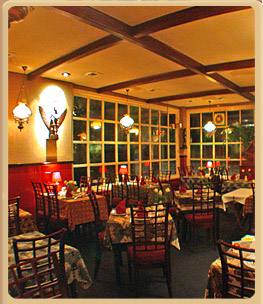 Sometimes the
dishes are brought out according to how spicy they
are, but again, you can mix and match. The
restaurants tend to be very casual and don't cost
very much at all. Nor, I am told, do they differ
radically in quality from one another in town.
Sometimes the
dishes are brought out according to how spicy they
are, but again, you can mix and match. The
restaurants tend to be very casual and don't cost
very much at all. Nor, I am told, do they differ
radically in quality from one another in town.We had a pleasant if somewhat underwhelming lunch at one of the better known rijsstaffel eateries, the 30-year-old Sama Sebo (Hoostraat 27), about ten minutes' walk from the Museum District. The place looks like a pub up front; the dining room (left) could use an update and a rehab; the service is by rote. The food is good, according to which dishes you sample; some of them seemed like they'd been sitting on the steam table too long. But there was definitely a lot of flavor and spice.
The full rijsstaffel runs a modest 29.50 euros ($38.50) per person, and, since I haven't the acumen or space enough to describe them all, let me just list them all: Nasi, Sajor, Babi Ketjap, Daging Madura, Ajam, Sateh, Krupuk, S.G. Sajoran, S.G. Tahu, S.G. Kering, Gado Gado, Serundeng, Pisang Goreng, Rudjak Manis, Atjar, Sambal and Katjang. Smaller versions made be had for 16.50 euros.
To read Part One of this article on Amsterdam, click here.
❖❖❖
NEW
YORK CORNER
by
John Mariani
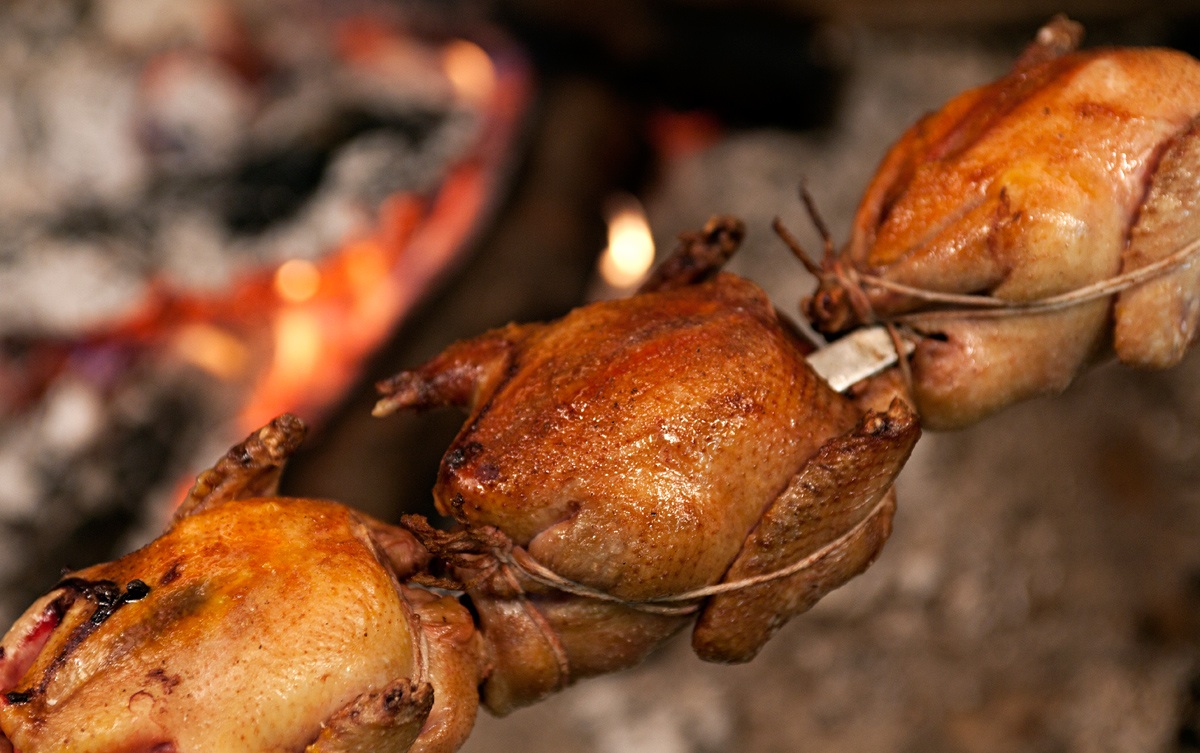 Mas (la grillade)
Mas (la grillade)
28
Seventh Avenue South
212-255-1795
As
everybody knows, in Old French a mas is a stone
farm house or small estate where as much as
possible, the food comes from its own fields or
nearby, an ancient and obvious idea that predates
modern locavorism by millennia. About five years ago
Chef Galen Zamarra (below)
opened Mas (Farmhouse) in Greenwich Village to wide
applause; its décor had a rusticity that was
both comfortable and sophisticated, a nook-like
restaurant with a menu stressing simple goodness. This
fall Zamarra, with partner Eric Blinderman, debuted
Mas (la grillade), and about the only thing about it I
can't applaud are those eccentric parentheses.
Just about everything else about this marvelous
restaurant is a revelation of good taste, based on the
deceptively simple notion that you can turn out
wonderful food from a wood-burning stove. (Note the
large wheel in the photo to the right, which allows
the cooks to raise or lower the food to get the right
temperature.) If such a technique seems restrictive,
just point anywhere on the menu--vegetables, fish,
meats--and you'll be amazed how 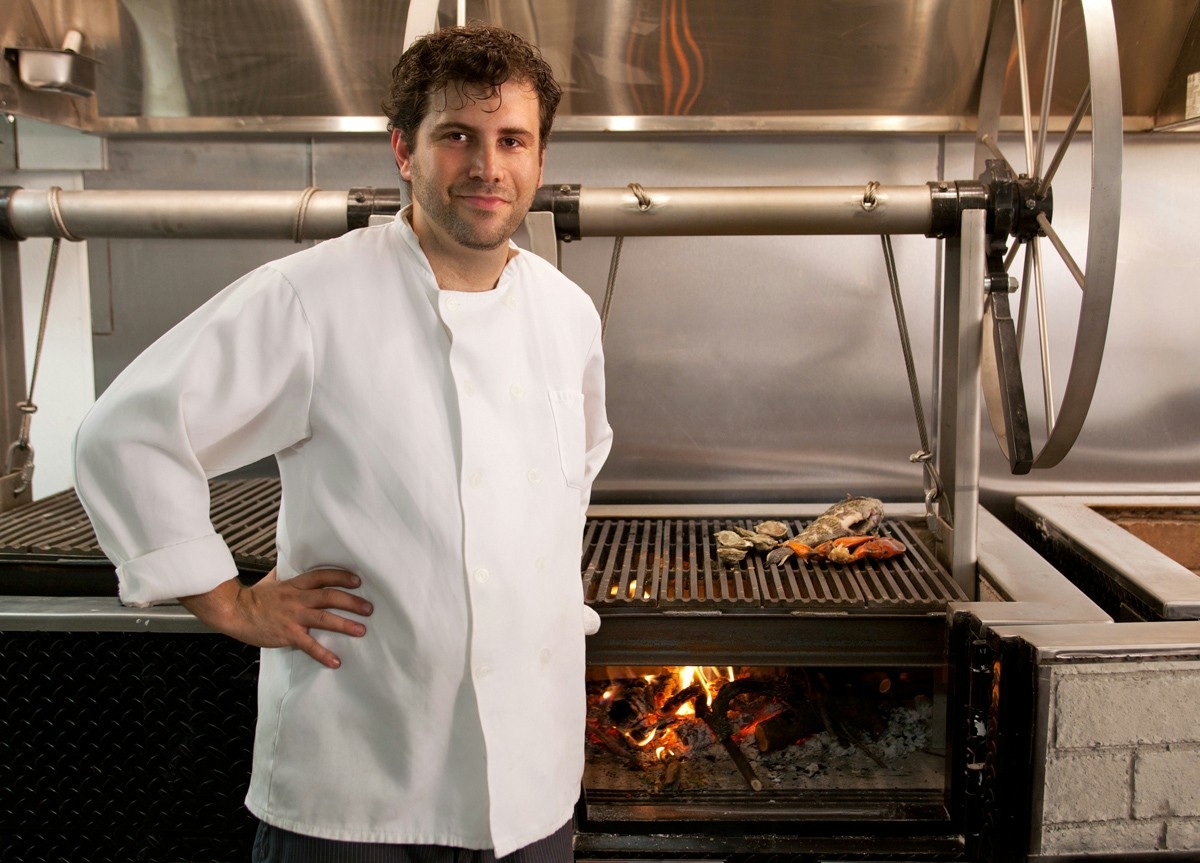 flavorful they all are when
treated to Zamarra's way with a flame.
flavorful they all are when
treated to Zamarra's way with a flame.
Within that context, he has
mastered grilling, smoking, charring, even steaming,
from grilled baby squid stuffed with bay leaves, baby
arugula salad, and grilled lemon to a fig tart with
smoked ice cream. Of course, cooking over a
hardwood fire is as ancient as the day a caveman, or
more probably a cavewoman, discovered that a burnt
piece of meat tasted a whole lot better than a raw
piece of meat. Mas (la grillade)'s distinction
is in seeing just how far one can go with the idea
without getting zealously gimmicky. "What we're doing at Mas (la
grillade) is the antithesis of molecular
gastronomy," says Zamarra. "Cooking
over live wood coals has nothing to do with
transforming food into theater, but rather
celebrates the natural properties of foods and
flavor. This
cooking technique delivers simple, yet
sophisticated, cuisine. I can't emphasize enough
how critical the quality of the raw ingredients
must be to make this concept work." And it
shows.
The main dining room seats 80, with
two floors and different levels of ceilings, a small
bar up front, and the décor evokes a farmhouse
spaciousness and coziness, with charred white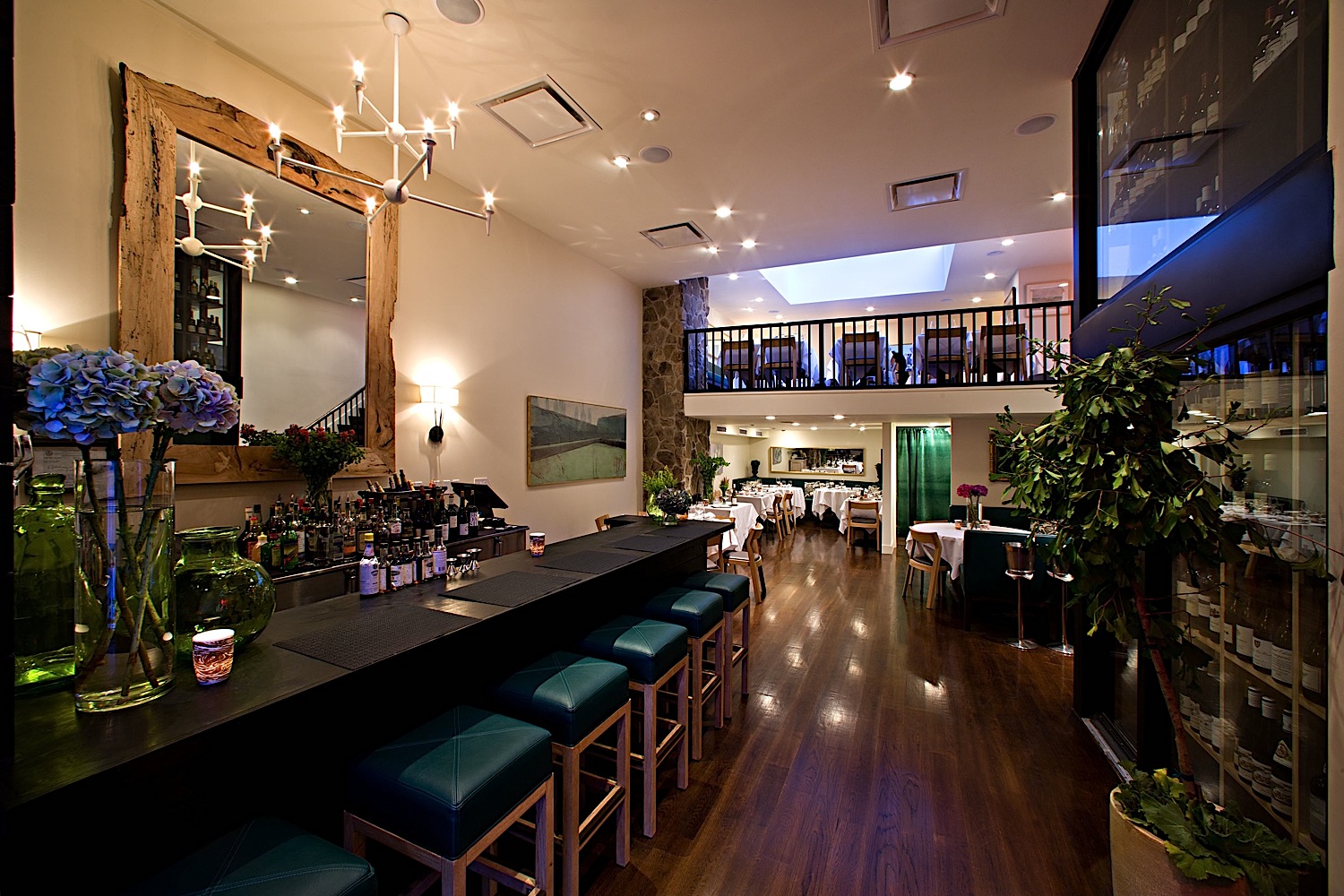 oak planks and maple. Fabrics are
Provençal, the spindly white chandelier French,
the mirror is framed in old barn wood, and there is
artwork on wood panels and photos of farm
landscapes. Upstairs is a lovely skylight.
The sound level is not too bad, with civilized
conversation possible.
oak planks and maple. Fabrics are
Provençal, the spindly white chandelier French,
the mirror is framed in old barn wood, and there is
artwork on wood panels and photos of farm
landscapes. Upstairs is a lovely skylight.
The sound level is not too bad, with civilized
conversation possible.
The beverage list, by general
manager Christopher Bender, is sensibly, fairly priced
in all wine categories, with plenty to choose from
under $60, strong in Rhône bottlings and an
extensive beer list.
There are both "small plates" and
appetizers; of the former I loved the grilled tartine of
sunchoke puree, smoked butternut confit, and grilled
green onions, and we delighted in squeezing out
succulent gloves of garlic that had been pit roasted
within their shell, glossed with olive oil and served
with grilled country bread. The appetizers we
tried included a fascinating tour de force of grilled
Romaine lettuce with house-cured lamb bacon and a
buttermilk and blue cheese dressing and grilled
croutons, that smoke adding measurably to the textures
of all the other elements. Artichokes à la chapa
came with grilled chanterelles and a hazelnut
mayonnaise. And then came something so amazingly
delicious that I could have stopped cold right then: a
baked potato, which was actually cooked in aluminum
foil--anathema to me anywhere else, but here it gave
the tender sweetness of the white potato a moist
texture that was just terrific. There was also a good
deal of butter in the deal, which helps enormously. 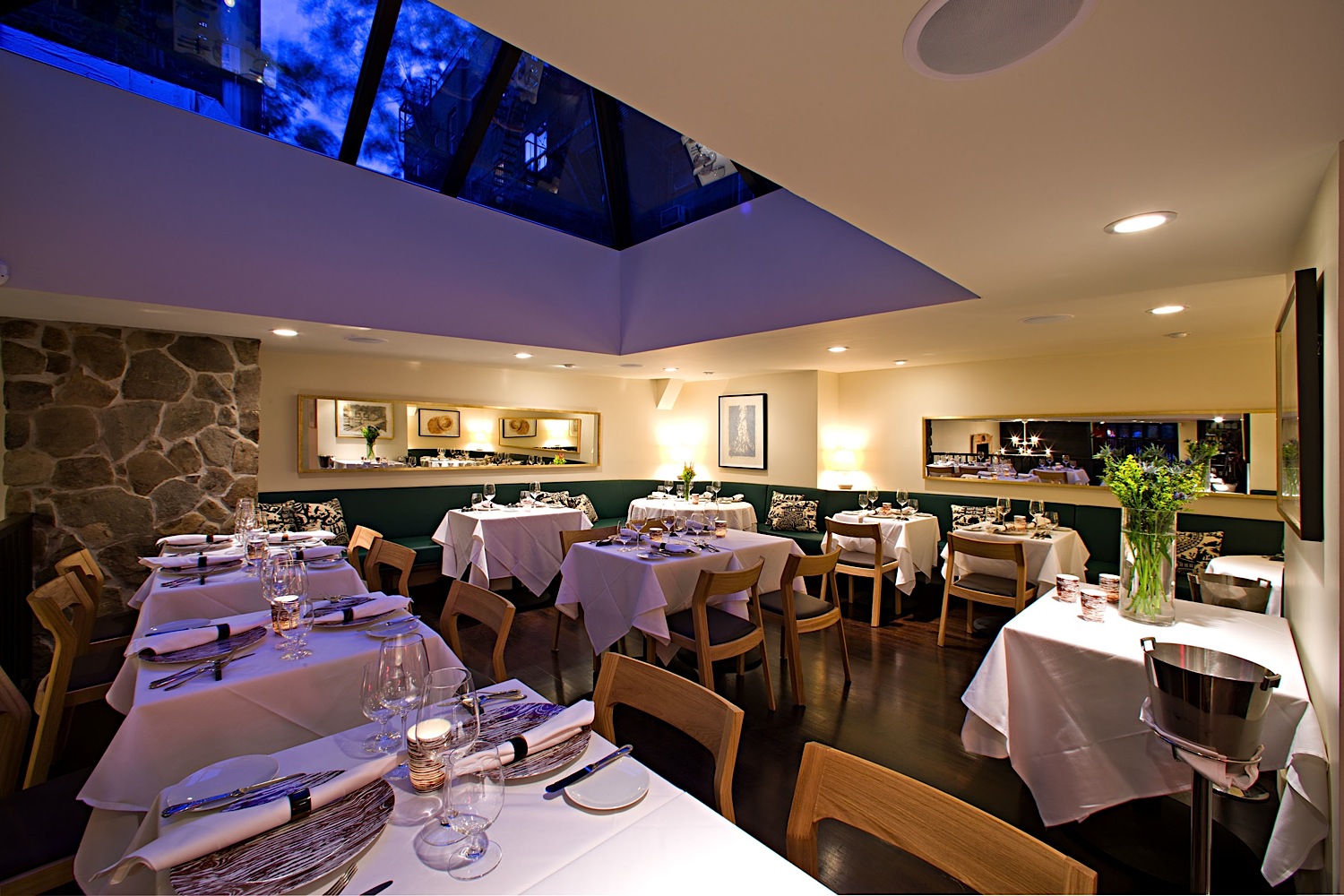
For the main
courses, there is spit-roasted squab (above), which we
didn't have a chance to try, and grilled wild striped
bass with parsley-walnut gremolata, and a grilled whole
whiting rubbed with salt and herbs, a dish so simple
and so good that you have to wonder how it could
possibly be improved by the addition of anything else.
Also excellent was grilled rack of lamb, its rich fat
intact, served with red wine and shallot butter.
Side dishes like baby fennel and
pears, and Brussels sprouts with lamb bacon, were
equally as impressive.
For dessert pastry chef Catrine
Oscarson keeps to the same simplicity in her
creations, nothing too lavish, nothing too composed. I
loved the grilled pumpkin-chocolate tart with toasted
marshmallows, white chocolate sorbet and candied
pumpkin seeds, and her maple cheesecake
brûlée with grilled persimmon, pear
sorbet and smoked walnut crumble is the wintery-est
dessert I can imagine.
Now what does all this cost? Much
less than you'd think, with small plates $3-$6,
appetizers $10-$18, and main courses$24-$49 (that last
for a NY strip steak). For $40 a
vegetarian could contentedly gobble up all the
side dishes (aside from the lamb bacon), and a
six-course menu is offered at a very reasonable $95.
Zamarra is not trying to be
revolutionary here. Instead he is insistent that his
ideas are sound and add tremendous flavor to his food,
by a technique as old as cave dwelling. Time
maybe to bring those ideas back to the dinner table.
Mas (la grillade) is
open for lunch and dinner daily.
❖❖❖
Gin Seeks a Return to
the Spotlight
by John Mariani
 Ever
since James Bond ordered a “shaken, not stirred”
martini made with vodka, in Ian Fleming’s 1958 novel
“Dr. No,” gin’s popularity began to sink. While
vodka has cannily capitalized on the youth market,
gin—the other white liquor--hasn’t been a hot
category for decades. Gin sales have been soaring in
China, India and Russia, but elsewhere, except for
premium imports, sales have dropped or remained flat
in the top markets of the Philippines, the U.S.,
and, in Europe, Spain.
Ever
since James Bond ordered a “shaken, not stirred”
martini made with vodka, in Ian Fleming’s 1958 novel
“Dr. No,” gin’s popularity began to sink. While
vodka has cannily capitalized on the youth market,
gin—the other white liquor--hasn’t been a hot
category for decades. Gin sales have been soaring in
China, India and Russia, but elsewhere, except for
premium imports, sales have dropped or remained flat
in the top markets of the Philippines, the U.S.,
and, in Europe, Spain.
Of course, purists would never
dream of making a martini with anything but gin,
whose dryness is the subject of countless jokes, as
in the instructions to “have a bartender just glance
at the vermouth bottle” before pouring the gin into
a shaker. A few other classic cocktails demand gin,
the Gibson, the gimlet, the negroni, the French 75,
and the Singapore sling, but none has the cachet of
newer cocktails like the saketini or Cosmopolitan.
Three hundred years ago, gin was
all the rage. Originally created by Dutch physician
Franciscus
Sylvius, gin was used to treat
everything from gallstones to bubonic plague. Cheap
to produce, gin became the drink of the poor, with
7,500 gin shops in 18th-century
London,
whose squalor and dissipation were depicted in
Hogarth’s “Gin Lane” (left) engravings. One innkeeper of
the day advertized “Drunk for a penny, Dead drunk
for twopence, Clean straw for nothing!” During
Prohibition in America “bathtub gin” could literally
be made by anyone with access to neutral spirits.
Gin’s name derives from the Dutch
genever,
juniper, which is the principal flavoring distilled
with neutral spirits. All gins are genever but not
all genevers, which may have many different
flavorings, are gins. Minimum alcohol levels
required by the EU is 37.5 percent, in the U.S. 40.
The two main types are Hollands and London. The term
“London” once connoted a gin made in or near London,
but is now a general term.
For a full immersion course in
gin-ology, the requisite visit is to The
House of Bols Cocktail & Genever Experience
in Amsterdam, just across from the city’s Van Goh
Museum. During a self-guided tour you’ll learn the
history of the genever company founded by Lucas Bols
in 1575 and pass through a gorgeously lighted Hall
of Taste (below)
where you can touch and smell the ingredients that
go into genever, and sniff from 36 “puffers” of
flavorings from strawberry to white mint, coffee to
peach. Then you end off at a bar/lounge called the
World of Cocktails, where they’ll make you any of
hundreds of cocktails made from scores of Bols
genevers. There’s even a Ladies Night special
discount, and you can sign up for the Bols
Bartending Academy to become a registered bartender.
You will also learn the proper way to drink
genevers,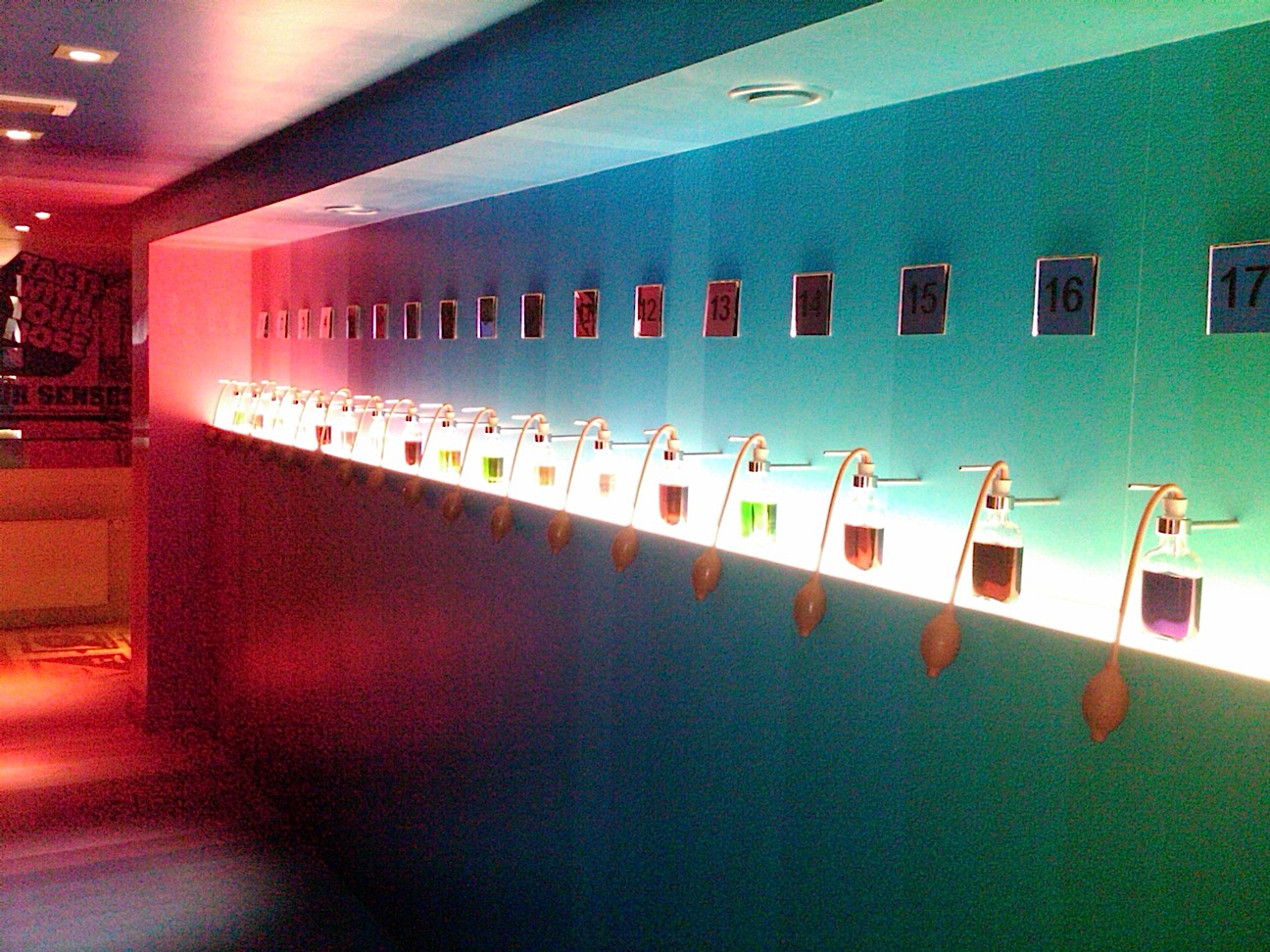 which involves leaning
over to take a sip from a full shot glass on the
table without picking it up. And if you follow a
beer with a chaser of genever, it’s called a kopstoot
(headbutt) in Flanders.
which involves leaning
over to take a sip from a full shot glass on the
table without picking it up. And if you follow a
beer with a chaser of genever, it’s called a kopstoot
(headbutt) in Flanders.
Bols sells its products
worldwide, but while new
vodkas—from improbable places--seem to appear in the
market every month, few producers besides artisanal
entrepreneurs are pouring investments into new gins. So I thought a tasting of
those well-established gins was an easy enough way
to tackle what’s out there.
Professionals usually taste whiskies cut with a
little water, but who would ever drink gin with
water? I tasted them straight.
Beefeater
London
Dry Gin ($20)—Beefeater is a true London
gin, “distilled in the heart of the city,” at a high
47 percent alcohol, so it’s very lush. When I poured
a little from the bottle, its aroma of juniper,
Seville oranges and lemon bounded out of the glass.
Very aromatic, Beefeater is complex and wonderful on
the rocks, but also good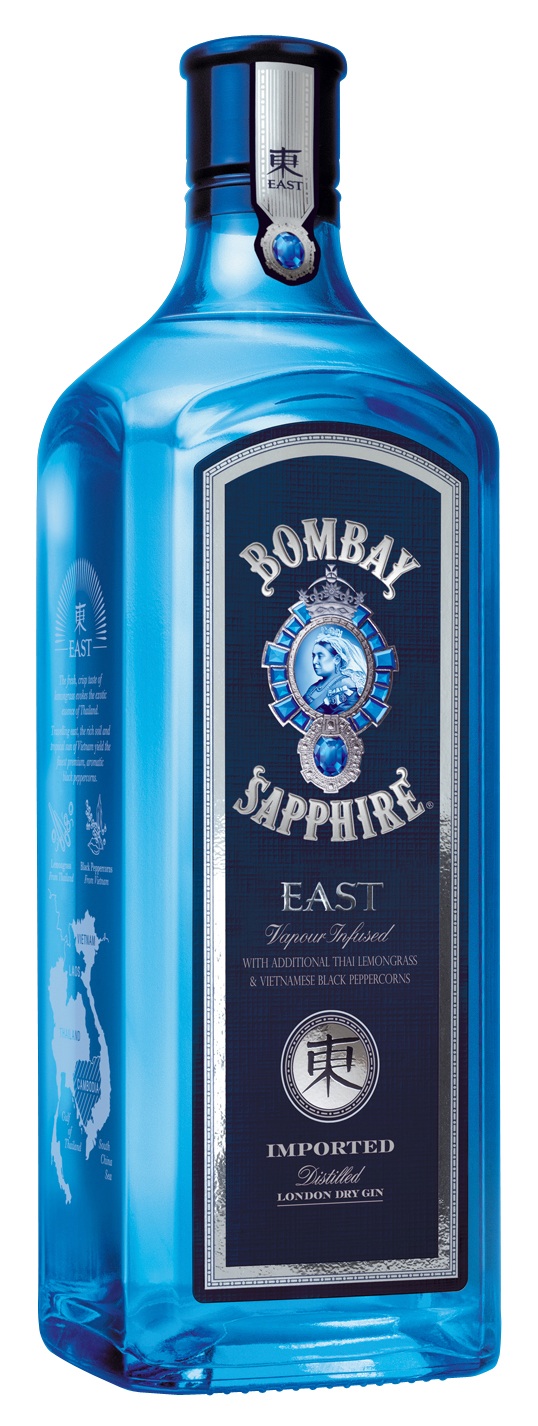 for a
Gibson, a martini garnished with cocktail
onions.
for a
Gibson, a martini garnished with cocktail
onions.
Gordon’s London Dry Gin ($17)—American
made, in Norwalk, CT, Gordon’s is based on a 1769
formula, with an “Appointment by Her Majesty the
Queen.” The weak nose is a little sharp and it’s a
fairly bland gin, minty but pretty bland, so it
would do well as a mixer with tonic or in a negroni.
Seagrams Extra Dry ($14)—“Extra Dry” means
little since all gins are distilled dry. This has a
light aroma of citrus, that floats over the palate,
with a distinctly American taste—punchy, not too
much alcohol (40 percent), fruity and fleshy, and at
$14 you can see why it’s such a big seller in the
U.S. My father, a smart man, always used to have
bottles of Seagrams and Gilbey’s in the liquor
cabinet. He’d use the Gilbey’s for those who asked
for gin on the rocks or with tonic, the Seagrams to
make a perfect martini. He was right.
Bombay Sapphire East ($25)—Worth every
penny, with 42 percent alcohol, this U.K. product is
a stylish gin rife with aromatics—many stenciled on
the bottle—like Thai lemongrass and Vietnamese black
peppercorns, that make it unusual and somewhat
exotic, the kind of gin you’d order in a Singapore
sling at the Raffles Bar in Singapore before heading
out to tend your rubber plantation. (Other Bombay
gins may have a different proof.)
Tanqueray
Special Dry English Gin ($25)—For many gin
lovers this is the apex of London gins, highly
refined, bursting with aromatics and tropical fruit,
all balanced with spice notes that linger on the
palate. It’s almost creamy and is best enjoyed on
its own or in the very driest martini a bartender
can possibly make, with lemon peel, not an olive.
John Mariani's wine and spirits column appears in Bloomberg Muse News, from which this story was adapted. Bloomberg News covers Culture from art, books, and theater to wine, travel, and food on a daily basis.
❖❖❖
OH,SHUT
UP
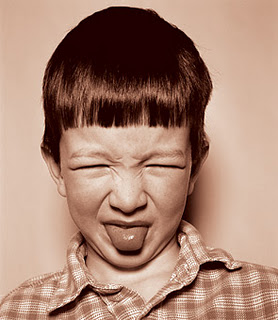 Prof. Dana Small,
associate professor of psychiatry at Yale University
School of Medicine and an associate professor of
psychology at Yale University who runs Yale University's
Affective Sensory Neuroscience Laboratory has given a
presentation titled "The Flavor Modality," in which
she describes taste this way: "When we 'taste,'
we also touch the food or drink in our mouths and
sense its odor via retronasal olfaction. The term
flavor describes this multimodal experience. The aim
of this lecture will be to describe how the
independent sensations of taste, touch and smell
converge to create unitary flavor percepts and how,
through experience, the brain encodes these 'flavor
objects' and their associated physiological
significance. Psychophysical and neuroimaging
data will be presented to support the existence of a
binding mechanism, possibly residing in the
somatomotor mouth area, that underlies illusory
processes that bring taste, touch and smell into a
common spatial and temporal field. Activation of this
mechanism then allows flavor objects that reside in
the insular cortex to become associated with the
post-ingestive consequences of feeding, which then
drives flavor preference formation."
Prof. Dana Small,
associate professor of psychiatry at Yale University
School of Medicine and an associate professor of
psychology at Yale University who runs Yale University's
Affective Sensory Neuroscience Laboratory has given a
presentation titled "The Flavor Modality," in which
she describes taste this way: "When we 'taste,'
we also touch the food or drink in our mouths and
sense its odor via retronasal olfaction. The term
flavor describes this multimodal experience. The aim
of this lecture will be to describe how the
independent sensations of taste, touch and smell
converge to create unitary flavor percepts and how,
through experience, the brain encodes these 'flavor
objects' and their associated physiological
significance. Psychophysical and neuroimaging
data will be presented to support the existence of a
binding mechanism, possibly residing in the
somatomotor mouth area, that underlies illusory
processes that bring taste, touch and smell into a
common spatial and temporal field. Activation of this
mechanism then allows flavor objects that reside in
the insular cortex to become associated with the
post-ingestive consequences of feeding, which then
drives flavor preference formation."
In Providence, RI, at
Cook & Brown Public House, chef/owner Nemo Bolin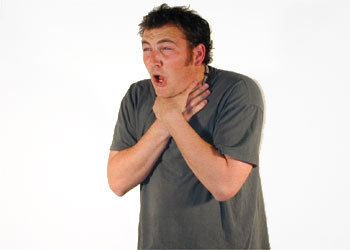 says the restaurant's most frequently
stolen items are the polished black rocks they use to
hold down checks.
says the restaurant's most frequently
stolen items are the polished black rocks they use to
hold down checks.
Any of John Mariani's
books below may be ordered from amazon.com.
 |
My latest book, written with Jim Heimann and Steven Heller, Menu Design in America, 1850-1985 (Taschen Books), has just appeared, with nearly 1,000 beautiful, historic, hilarious, sometimes shocking menus dating back to before the Civil War and going through the Gilded Age, the Jazz Age, the Depression, the nightclub era of the 1930s and 1940s, the Space Age era, and the age when menus were a form of advertising in innovative explosions of color and modern design. The book is a chronicle of changing tastes and mores and says as much about America as about its food and drink.
“Luxuriating vicariously in the pleasures of this book. . . you can’t help but become hungry. . .for the food of course, but also for something more: the bygone days of our country’s splendidly rich and complex past. Epicureans of both good food and artful design will do well to make it their cofee table’s main course.”—Chip Kidd, Wall Street Journal.
“[The menus] reflect the amazing craftsmanship that many restaurants applied to their bills of fare, and suggest that today’s restaurateurs could learn a lot from their predecessors.”—Rebecca Marx, The Village Voice. |
"Eating Italian will
never be the same after reading
John Mariani's entertaining and
savory gastronomical history of
the cuisine of Italy and how it
won over appetites worldwide. . .
. This book is such a tasteful
narrative that it will literally
make you hungry for Italian food
and arouse your appetite for
gastronomical history."--Don
Oldenburg, USA Today. "Italian
restaurants--some good, some glitzy--far
outnumber their French rivals. Many of
these establishments are zestfully described
in How Italian Food Conquered the World, an
entertaining and fact-filled chronicle by
food-and-wine correspondent John F.
Mariani."--Aram
Bakshian Jr., Wall Street Journal. "Equal parts
history, sociology, gastronomy, and just
plain fun, How Italian Food Conquered the
World tells the captivating and delicious
story of the (let's face it) everybody's
favorite cuisine with clarity, verve and
more than one surprise."--Colman Andrews,
editorial director of The Daily
Meal.com. "A fantastic and fascinating
read, covering everything from the influence
of Venice's spice trade to the impact of
Italian immigrants in America and the
evolution of alta cucina. This book will
serve as a terrific resource to anyone
interested in the real story of Italian
food."--Mary Ann Esposito, host of PBS-TV's
Ciao
Italia. "John Mariani has written the
definitive history of how Italians won their
way into our hearts, minds, and
stomachs. It's a story of pleasure over
pomp and taste over technique."--Danny Meyer,
owner of NYC restaurants Union Square Cafe,
Gotham Bar & Grill, The Modern, and
Maialino.
|
 |
 |
 |
 |
 |
 |
 |
 |
 Everett Potter's Travel Report:
Everett Potter's Travel Report: 
 Eating Las Vegas
is the new on-line site for Virtual Gourmet
contributor John A. Curtas., who since 1995
has been commenting on the Las Vegas food
scene and reviewing restaurants for Nevada
Public Radio. He is also the
restaurant critic for KLAS TV, Channel 8 in
Las Vegas, and his past reviews can be
accessed at KNPR.org.
Click on the logo below to go directly to
his site.
Eating Las Vegas
is the new on-line site for Virtual Gourmet
contributor John A. Curtas., who since 1995
has been commenting on the Las Vegas food
scene and reviewing restaurants for Nevada
Public Radio. He is also the
restaurant critic for KLAS TV, Channel 8 in
Las Vegas, and his past reviews can be
accessed at KNPR.org.
Click on the logo below to go directly to
his site.

Tennis Resorts Online: A Critical Guide to the World's Best Tennis Resorts and Tennis Camps, published by ROGER COX, who has spent more than two decades writing about tennis travel, including a 17-year stretch for Tennis magazine. He has also written for Arthur Frommer's Budget Travel, New York Magazine, Travel & Leisure, Esquire, Money, USTA Magazine, Men's Journal, and The Robb Report. He has authored two books-The World's Best Tennis Vacations (Stephen Greene Press/Viking Penguin, 1990) and The Best Places to Stay in the Rockies (Houghton Mifflin, 1992 & 1994), and the Melbourne (Australia) chapter to the Wall Street Journal Business Guide to Cities of the Pacific Rim (Fodor's Travel Guides, 1991).

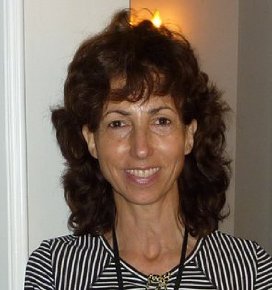
The Family Travel Forum - A
community for those who "Have Kids, Still Travel" and
want to make family vacations more fun, less work and
better value. FTF's travel and parenting features,
including reviews of tropical and ski resorts, reunion
destinations, attractions, holiday weekends, family
festivals, cruises, and all kinds of vacation ideas
should be the first port of call for family vacation
planners. http://www.familytravelforum.com/index.html
ALL YOU NEED BEFORE YOU GO


MARIANI'S VIRTUAL GOURMET
NEWSLETTER is published weekly. Editor/Publisher: John
Mariani.
Contributing Writers: Christopher Mariani, Robert Mariani,
John A. Curtas, Edward Brivio, Mort Hochstein,
Suzanne Wright, and Brian Freedman. Contributing
Photographers: Galina Stepanoff-Dargery,
Bobby Pirillo. Technical Advisor: Gerry McLoughlin.
© copyright John Mariani 2011
